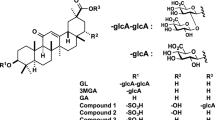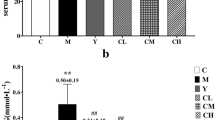Abstract
Purpose
Urine samples were obtained from a previously completed study that showed lentil consumption attenuates the increase in blood pressure that occurs over time in spontaneously hypertensive rats (SHRs). The objective of the present study was to compare the metabolite profile of the urine samples from control and lentil-fed SHR in relation to the compounds present in lentils but not in other pulses.
Methods
The urine samples were from 17-week-old, male SHR fed semi-purified diet prepared with powder (30 %, w/w) from cooked whole pulses or a pulse-free control diet (n = 8/group) for 4 weeks. Pulse powders, control diet and urine samples were extracted using acetonitrile and analyzed by a high-performance liquid chromatography/quadrupole time-of-flight mass spectrometry (LC-QTOF-MS).
Results
Twenty-seven metabolites were significantly different in urine samples from lentil-fed SHR compared to SHR fed control diet, but only 7 were not present in the urine of SHR fed other pulses. Of these metabolites, only citrulline is linked to blood pressure regulation via production of the vasodilator nitric oxide (NO). Several arginine-related compounds that are NO synthase substrates or inhibitors were detected in lentils but not the control diet or other pulse powders.
Conclusions
Consumption of lentils increases the availability of arginine and several related compounds that could potentially elevate production of NO and contribute to the blood pressure-lowering effects of lentil-rich diets.



Similar content being viewed by others
References
Wang YF, Wang QJ (2004) The prevalence of prehypertension and hypertension among US adults according to the new joint national committee guidelines. Arch Internal Med 164:2126–2134. doi:10.1001/archinte.164.19.2126
Chobanian AV, Bakris GL, Black HR, Cushman WC, Green LA, Izzo JLJ, Jones DW, Materson BJ, Oparil S, Wright JTJ, Roccella EJ (2003) Seventh report of the joint national committee on prevention, detection, evaluation, and treatment of high blood pressure. Hypertension 42:1206–1252
Huang WY, Davidge ST, Wu JP (2013) Bioactive natural constituents from food sources—potential use in hypertension prevention and treatment. Crit Rev Food Sci Nutr 53:615–630. doi:10.1080/10408398.2010.550071
Curran J (2012) The nutritional value and health benefits of pulses in relation to obesity, diabetes, heart disease and cancer. Br J Nutr 108:S1–S2
Roy F, Boye JI, Simpson BK (2010) Bioactive proteins and peptides in pulse crops: pea, chickpea and lentil. Food Res Int 43:432–442. doi:10.1016/j.foodres.2009.09.002
Jayalath VH, de Souza RJ, Sievenpiper JL, Ha V, Chiavaroli L, Mirrahimi A, Di Buono M, Bernstein AM, Leiter LA, Kris-Etherton PM, Vuksan V, Beyene J, Kendall CW, Jenkins DJ (2014) Effect of dietary pulses on blood pressure: a systematic review and meta-analysis of controlled feeding trials. Am J Hypertens 27:56–64. doi:10.1093/ajh/hpt155
Mukai Y, Sato S (2009) Polyphenol-containing azuki bean (Vigna angularis) extract attenuates blood pressure elevation and modulates nitric oxide synthase and caveolin-1 expressions in rats with hypertension. Nutr Metab Cardiovasc Dis 19:491–497
Hanson MG, Zahradka P, Taylor CG (2014) Lentil-based diets attenuate hypertension and large-artery remodelling in spontaneously hypertensive rats. Br J Nutr 111:690–698. doi:10.1017/S0007114513002997
Akira K, Masu S, Imachi M, Mitome H, Hashimoto T (2012) A metabonomic study of biochemical changes characteristic of genetically hypertensive rats based on 1H NMR spectroscopic urinalysis. Hypertens Res 35:404–412
Onuh JO, Girgih AT, Ievari-Shariati S, Malomo SA, Aluko RE, Aliani M (2015) Kinetics of in vitro renin and angiotensin converting enzyme inhibition by chicken skin protein hydrolysates and their blood pressure lowering effects in spontaneously hypertensive rats. J Funct Foods 14:133–143. doi:10.1016/j.jff.2015.01.031
Grant J, Whitehurst K, Taylor CG, Zahradka P, Aliani M (2015) Urinary metabolomics profile of genetically obese rats using liquid chromatography quadrupole time-of-flight mass spectrometry. Jacobs J Biomark 1:015
Iwaniak A, Minkiewicz P, Darewicz M (2014) Food-originating ACE inhibitors, including antihypertensive peptides, as preventive food components in blood pressure reduction. Compr Rev Food Sci Food Saf 13:114–134
Xie J, Pierce JG, James RC, Okano A, Boger DL (2011) A redesigned Vancomycin engineered for dual D-Ala-D-Ala and D-Ala-D-Lac binding exhibits potent antimicrobial activity against Vancomycin-resistant bacteria. J Am Chem Soc 133:13946–13949
Lal KJ, Dakshinamurti K, Thliveris J (1996) The effect of vitamin B6 on the systolic blood pressure of rats in various animal models of hypertension. J Hypertens 14:355–363
McMahon JA, Skeaff CM, Williams SM, Green TJ (2007) Lowering homocysteine with B vitamins has no effect on blood pressure in older adults. J Nutr 137:1183–1187
Chang YO (1965) Excretion of total nitrogen, lysine and methionine by rats as affected by the type of carbohydrate in the diet. J Nutr 85:207–212
Semba RD, Sun K, Schwartz AV, Varadhan R, Harris TB, Satterfield S, Garcia M, Ferrucci L, Newman AB, Health ABCS (2015) Serum carboxymethyl-lysine, an advanced glycation end product, is associated with arterial stiffness in older adults. J Hypertens 33:797–803. doi:10.1097/HJH.0000000000000460 (discussion 803)
Thornalley PJ, Rabbani N (2014) Detection of oxidized and glycated proteins in clinical samples using mass spectrometry–a user’s perspective. Biochim Biophys Acta 1840:818–829. doi:10.1016/j.bbagen.2013.03.025
van de Poll MCG, Siroen MPC, van Leeuwen PAM, Soeters PB, Melis GC, Boelens PG, Deutz NEP, Dejong CHC (2007) Interorgan amino acid exchange in humans: consequences for arginine and citrulline metabolism. Am J Clin Nutr 85:167–172
Schulman SP, Becker LC, Kass DA, Champion HC, Terrin ML, Forman S, Ernst KV, Kelemen MD, Townsend SN, Capriotti A, Hare JM, Gerstenblith G (2006) l-arginine therapy in acute myocardial infarction - The Vascular Interaction With Age in Myocardial Infarction (VINTAGE MI) randomized clinical trial. Jama-J Am Med Assoc 295:58–64. doi:10.1001/jama.295.1.58
Dioguardi FS (2011) To give or not to give? lessons from the arginine paradox. J Nutrigenet Nutrigenom 4:90–98. doi:10.1159/000327777
van der Zwan LP, Davids M, Scheffer PG, Dekker JM, Stehouwer CD, Teerlink T (2013) L-Homoarginine and l-arginine are antagonistically related to blood pressure in an elderly population: the Hoorn study. J Hypertens 6:1114–1123
Feliers D, Lee DY, Gorin Y, Kasinath BS (2015) Symmetric dimethylarginine alters endothelial nitric oxide activity in glomerular endothelial cells. Cell Signal 27:1–5. doi:10.1016/j.cellsig.2014.09.024
Angulo J, Cuevas P, Fernandez A, Gabancho S, Allona A, Martin-Morales A, Moncada I, de Tejada IS (2003) Activation and potentiation of the NO/cGMP pathway by N-G-hydroxyl-l-arginine in rabbit corpus cavernosum under normoxic and hypoxic conditions and ageing. Br J Pharmacol 138:63–70. doi:10.1038/sj.bjp.0705027
Korth HG, Sustmann R, Thater C, Butler AR, Ingold KU (1994) on the mechanism of the nitric-oxide synthase-catalyzed conversion of N-omega-hydroxy-l-arginine to citrulline and nitric-oxide. J Biol Chem 269:17776–17779
Moali C, Boucher JL, Sari MA, Stuehr DJ, Mansuy D (1998) Substrate specificity of NO synthases: detailed comparison of l-arginine, homo-l-arginine, their N-omega-hydroxy derivatives, and N-omega-hydroxynor-l-arginine. Biochemistry 37:10453–10460. doi:10.1021/bi980742t
Vetrovsky P, Boucher JL, Schott C, Beranova P, Chalupsky K, Callizot N, Muller B, Entlicher G, Mansuy D, Stoclet JC (2002) Involvement of NO in the endothelium-independent relaxing effects of N(omega)-hydroxy-l-arginine and other compounds bearing a C = NOH function in the rat aorta. J Pharmacol Exp Ther 303:823–830. doi:10.1124/jpet.102.038612
Xuan CL, Yao FR, Guo LR, Liu Q, Chang SK, Liu KX, Sun CW (2013) Comparison of extracts from cooked and raw lentil in antagonizing angiotensin II-induced hypertension and cardiac hypertrophy. Eur Rev Med Pharmacol Sci 17:2644–2653
Yao FR, Sun CW, Chang SKC (2012) Lentil polyphenol extract prevents angiotensin II-induced hypertension, vascular remodelling and perivascular fibrosis. Food Funct 3:127–133. doi:10.1039/C1fo10142k
Acknowledgments
Funding was provided by a Natural Sciences and Engineering Research Council (NSERC) of Canada Strategic Grant (Peter Zahradka, Carla G Taylor and Michel Aliani; STPGP-397306), Canada Foundation for Innovation (CFI; Michel Aliani) and a scholarship (Mathew Hanson) from the Food Advancement Through Science and Training (FAST) program funded by NSERC CREATE.
Author contributions
MH prepared the samples, MH and MA analyzed the data, and all authors contributed to the study design, data interpretation, and writing and editing of the manuscript.
Author information
Authors and Affiliations
Corresponding author
Electronic supplementary material
Below is the link to the electronic supplementary material.
Rights and permissions
About this article
Cite this article
Hanson, M., Zahradka, P., Taylor, C.G. et al. Identification of urinary metabolites with potential blood pressure-lowering effects in lentil-fed spontaneously hypertensive rats. Eur J Nutr 57, 297–308 (2018). https://doi.org/10.1007/s00394-016-1319-5
Received:
Accepted:
Published:
Issue Date:
DOI: https://doi.org/10.1007/s00394-016-1319-5




